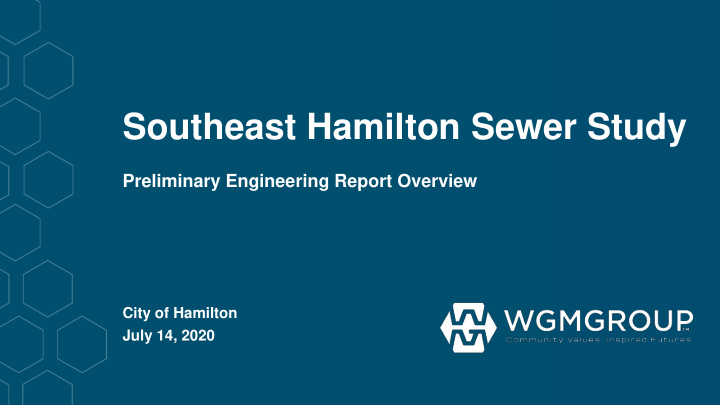



Southeast Hamilton Sewer Study Preliminary Engineering Report Overview City of Hamilton July 14, 2020
Preparation Team WGM Group City of Hamilton
Goals and Objectives • Identify existing nutrient loads from on site wastewater disposal in SE Hamilton Area – aquifer and Bitterroot River • Consider population projections and future wastewater generation • Evaluate alternative for wastewater treatment that will protect future water quality – public health & environmental • Provide document for future wastewater planning within the SE Hamilton Area
Project Process • Follow Standard Preliminary Engineering Report Outline • Provide notice to state and federal agencies for comments • Complete an Uniform Environmental Checklist • Evaluate various alternatives • Prepare cost estimates • Identify Preferred Alternative
Study Area • Within the 2006 WWFP Planning Area • 1,200 Total Acres • 1,002 Current Parcels • Current Population = 2,505 • 13 Different Subbasin Collection Areas • 2 Outlying Subbasin Areas • Golf Course Road • Grantsdale
Existing Conditions • No Regional Public Sewer or Water Infrastructure • Individual Wells (+1,000) • Individual Septic Systems – Some of Unknown Condition (+1,000) Seepage Pits, Septic Tanks, Drainfields, Others Upgradient of City of Hamilton Drinking Water Wells
Need for Project • Public Health – Nitrates in Aquifer Health Effects - Methemoglobeinemia (Blue Baby Syndrome) Sensitive Populations – Infants, Pregnant Women, Dialysis Patients MCL = 10 mg/L (US EPA) • Environmental Health – Bitterroot River Nutrient Loading Increased Algae Growth Decreased Oxygen Fish Fatalities
Nutrient Loading Model • ArcNLET – GIS based model • Uses topography, soils, septic system locations • Septic System Ground Water Bitterroot River • Benefits: Relatively quick and inexpensive model to run Easy identification of locations with high nutrient loading Planning level nutrient estimation tool
Existing Conditions Septic Plume
Projected Conditions Septic Plume Continued Onsite Septic Daly Ave Area Systems Well No. 2 Well No. 5 Well No. 1 Shady Ave Area Westana Mobile Home Park
Nutrient Loading Model Results • High density housing on septic systems results in significant nutrient loads to groundwater wells and Bitterroot River • Aquifer Nitrogen Loading: 16,700 lbs/year 21,000 lbs/year • Bitterroot River Nitrogen Loading: 11,000 lbs/year 13,600 lbs/year • Daly Area: High groundwater impact, greater distance to river • Shady Area: High groundwater and river impact • Grantsdale Rd/Westana mobile park: remote location
Population Trends • Parcels ≥ 5 acres – high potential density development • Parcels ≤ 1 acre – low potential density development • Parcel Size ~ Projected % Development • % Development = Total Future Lots • Future Population = 2.5 People/Unit
Population Trends
Population Projections
Wastewater Forecasting • 85 gallons/capita/day (2006 Hamilton Wastewater Facility Master Plan) • Peaking Factor for Conservative Estimate • Peak Flows Sensitivity – Storm and Sewer Analysis Application (SSA)
Future Scenarios Bitterroot River Nutrient Loading
Sewer Master Plan • Interceptor Mains (Backbone) – SSA for Pipe Sizing • Collections Mains for Side Streets • Potential for Phased Development – Decentralized Treatment • Considerations for Development Outside of Sewer Study Area
Cost Estimate Example Daly Interceptor – Detailed Cost Breakdown
Cost Estimate Example Focus Areas for Immediate Improvements
Benefits of the Preferred Alternative • Improves public health by reducing sewage-related pollutants discharged to aquifer providing safe and reliable drinking water. • Provides protection to the Bitterroot River by reducing nutrient loading that reach surface water. • Provides improved opportunity for economic development. • Provides a resource for future wastewater planning in the SE Hamilton Area.
THANK YOU!
Recommend
More recommend